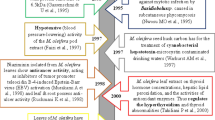Abstract
The major extractable components of two species identified as having high oil or polyphenol contents were characterized in detail.Asclepias linaria, a desert milkweed, contains 30.3% extractable material on a dry-weight basis, andIlex verticillata contains 41.5% extractable material on a dry-weight basis. Important components inA. linaria oil fractions are triterpene alcohols and esters, wax, and natural rubber; fatty acid triglycerides were nearly absent.Ilex verticillata oil fractions were predominantly triglycerides with some triterpene fatty acid esters. The more polar polyphenol fraction contained sugars and sugar esters of fatty acids and triterpene acids. The polyphenol fraction from these plants is better described as a saponin fraction. Because the crude saponin fraction represents 10.7% of the dry weight of A. linaria and 18.9% of the dry weight ofI. verticillata and because the saponin fractions showed good emulsifying properties, the refined extract of these plants might be used as a biodegradable surfactant.
Resumen
Los componentes mayores que se pueden extraer de dos especies identificadas como teniendo cantidades de mucha esencia o cantidades de polifenolfueron caracterizados en detalle.Asclepias linaria, un vencetósigo del desierto, tiene 30.3% material que se puede extraer en un base de peso seco, yIlex verticillata tiene 41.5% material que se puede extraer en un base de peso seco. Componentes importantes enA. linaria fracciones de esencia son alcoholes de triterpenos y ésteres, cera, y goma natural. Triglicéridos de acidos grasos casifueron no existentes.Ilex verticillata fracciones de esencia fueron triglicéridos predominantemente con algunas ésteres triterpenos de acidos grasos. La fractión polifenol mas polar contuvi azucares y ésteres de azucar de acidos grasos y acidos triterpenos. La fractión polifenol de estas plantas esta describida como una fractión saponina. Porque la fractión saponina cruda representa 10.7% del peso seco deA. linaria y 18.9% del peso seco deI. verticillata y porque las fracciónes saponinas muestraron buenas propiedades de emulsiar, es posible usar el extracto refinado de estas plantas como un detergente biogradable.
Similar content being viewed by others
Literature cited
Abbott, T. P., R. E. Peterson, J. B. McAlpine, L. W. Tjarks, and M. O. Bagby. 1989. A comparison of centrifugal countercurrent chromatography, nonaqueous reversed phase HPLC and Ag ion exchange column chromatography for the separation of triterpene acetates. J. Liquid Chromatogr. 2:2281–2301.
Adams, R. P., M. F. Balandrin, K. J. Brown, G. A. Stone, S. M. Gruel, and M. O. Bagby. 1986. Extraction of liquid fuels and chemicals from terrestrial higher plants. Part I. Yields from a survey of 614 western United States plant taxa. Biomass 9:255–292.
Anonymous. 1987. Growing industrial materials: renewable resources from agriculture and forestry. United States Department of Agriculture, Office of Critical Materials, Washington, DC.
Buchanan, R. A., I. M. Cull, F. H. Otey, and C. R. Russell. 1978. Hydrocarbon-and rubber-producing crops: evaluation of U.S. plant species. Econ. Bot. 32:131–145.
— F. H. Otey, and M. O. Bagby. 1980. Botanochemicals. Pages 1–22in T. Swain and R. Kleiman, ed., Recent advances in phytochemistry. Vol. 14. Plenum, New York.
Carr, M. E., B. S. Phillips, and M. O. Bagby. 1985. Xerophytic species evaluated for renewable energy resources. Econ. Bot. 39:505–513.
Roth, W. B., I. M. Cull, R. A. Buchanan, and M. O. Bagby. 1982. Whole plants as renewable energy resources: checklist of 508 species analyzed for hydrocarbon, oil, polyphenol, and protein. Trans. Illinois State Acad. Sci. 75:217–231.
Author information
Authors and Affiliations
Additional information
The mention of firm names or trade products does not imply that they are endorsed or recommended by the USDA over other firms or similar products not mentioned.
Rights and permissions
About this article
Cite this article
Abbott, T.P., Peterson, R.E., Tjarks, L.W. et al. Major Extractable Components in Asclepias linaria (Asclepiadaceae) and Ilex verticillata (Aquifoliaceae), Two Potential Hydrocarbon Crops. Econ Bot 44, 278–284 (1990). https://doi.org/10.1007/BF02860492
Received:
Accepted:
Issue Date:
DOI: https://doi.org/10.1007/BF02860492




